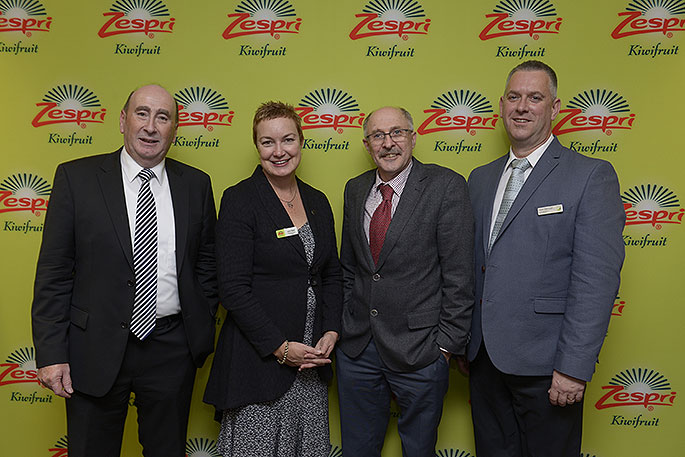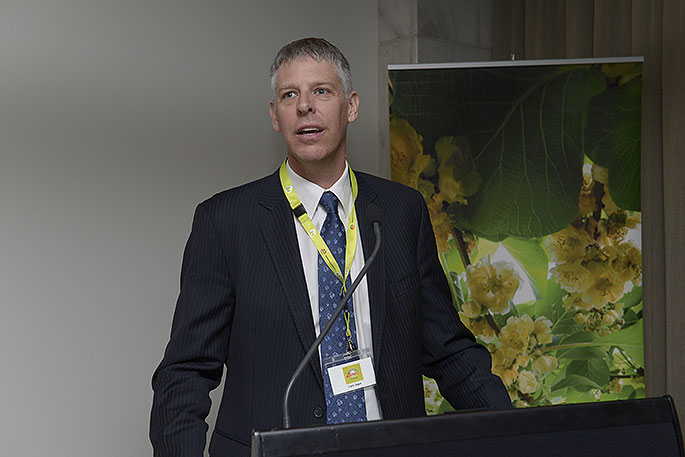A new report shows kiwifruit's contribution to New Zealand GDP is set to increase from $2.6 billion in 2015/16 to $6.14 billion in 2030, with an additional 29,000 New Zealand jobs, driven by the new cultivar Zespri SunGold.
The report from the University of Waikato shows the new varieties breeding programme for kiwifruit, supported by the New Zealand government for many years, has been a major contributor to the NZ economy.
Zespri SunGold Kiwifruit (also known as Gold3) came out of this breeding programme and the report finds that without it, the New Zealand industry would be less than half the size of these 2030 projections.
Minister for Economic Development, Hon Simon Bridges launched the report's finding in Parliament last night together with Zespri and Plant & Food Research which jointly run the kiwifruit new varieties breeding programme.
 Plant & Food Research's Bruce Campbell, Zespri's Carol Ward, Prof Frank Scrimgeour from University of Waikato and Plant & Food Research's Kieran Elborough.
Plant & Food Research's Bruce Campbell, Zespri's Carol Ward, Prof Frank Scrimgeour from University of Waikato and Plant & Food Research's Kieran Elborough.
Zespri General Manager Innovation Carol Ward says Zespri commissioned the report to better understand the impact the kiwifruit industry has in the regions, for Maori and for NZ as a whole, as well the growth ahead.
'The New Zealand kiwifruit industry has a goal of increasing kiwifruit consumption around the world and is on track to more than double global sales to $4.5 billion by 2025, driven by this great new kiwifruit variety, Zespri SunGold.
'We are grateful for the support of the New Zealand government over the past seven years through the MBIE Research Partnership Scheme, which has resulted in Zespri SunGold. Last season (2016/17) 46 million trays of Zespri SunGold were sold with an export value of $686 million, up 70 per cent from the previous year.
'The investment in this partnership – $13.5 million from the government and $29.2 million from Zespri, as well as significant internal funding from Plant & Food Research – shows the government's commitment to supporting the aim of the horticulture sector to double the value of its earnings to $10 billion per annum by 2020,” says Ms Ward.
Waikato University Professor Frank Scrimgeour says the report quantifies the contribution the kiwifruit industry and the new cultivar breeding programme makes to the economies of Bay of Plenty, Northland and New Zealand, as well as Maori growers, along with growth projections to 2030.
'The regional growth projections are very strong: in Bay of Plenty, kiwifruit accounts for 10,762 full-time equivalent (FTE) jobs now and an additional 14,329 jobs by 2030, along with a 135 percent increase of GDP contribution to $2.04 billion. Northland is set to increase by 506 jobs over the same period, with contribution to GDP set to increase 135 percent to $72 million.
 Zespri Chief Executive Lain Jager addressing the event in Parliament.
Zespri Chief Executive Lain Jager addressing the event in Parliament.
'It was encouraging to see Maori are also set to benefit from kiwifruit's growth, with grower revenue set to increase from $271 million to $638 million per year by 2030.
Professor Scrimgeour noted the kiwifruit industry is a leader in horticulture practice and international marketing, making it significant for the overall economy of New Zealand far beyond export receipts.
'The Plant & Food Research team is thrilled to have contributed to the New Zealand economy in such a positive way,” says Dr Bruce Campbell, COO of Plant & Food Research.
'Breeding a new cultivar is complex work, linking deep science knowledge with understanding of the needs of both growers and consumers.
"The long-term commitment by both Zespri and the New Zealand Government in the kiwifruit breeding programme has allowed us to deliver a game-changing new kiwifruit, for the horticultural industry and the nation. This is a great example of a NZ Inc investment focused on creating value by delighting consumers.”



0 comments
Leave a Comment
You must be logged in to make a comment.